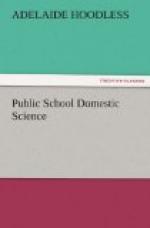Mr. Atkinson says, that “Cooking is the right application of heat for the conversion of food material.”
As much of our food requires cooking, how we shall cook it so as to render it more palatable, more digestible, and with the greatest economy of time, fuel and money, is an object deserving the most careful attention. The art of cooking lies in the power to develop certain flavors which are agreeable to the palate, or in other words, which “make the mouth water,” without interfering with the nutritive qualities of the food prepared, to understand by what method certain foods may be rendered more digestible, and to provide variety. Monotony of diet and of flavor lessens the appetite and fails to stimulate the digestive organs.
The chemical changes, produced by cooking food properly, aid digestion, beside destroying any germs which may be contained in the food. Nearly all foods—except fruit—require cooking. The digestibility of starch depends almost entirely upon the manner in which it is cooked, especially the cereal class. Gastric troubles are sure to follow the use of improperly cooked grains or starches. (See Chap. VII.)
Methods.
The following are the usual methods observed in cooking, viz.: (1) boiling, (2) stewing, (3) roasting, (4) broiling, (5) frying, (6) braising, (7) baking, (8) steaming.
BOILING.
Water boils at a temperature of 212 deg. F. Simmering should be at a temperature of from 175 deg. F. to 180 deg. F. When water has reached the boiling point, its temperature cannot be raised, but will be converted into steam; hence the folly of adding fuel to the fire when water has already reached the boiling point.
STEWING.
Stewing allows the juices of the meat to become dissolved in water heated to the simmering point. The juices thus dissolved are eaten with the meat. If not injured by the addition of rich sauces or fats, this is usually a very digestible method of preparing certain kinds of meat.
BROILING.
Broiling is cooking directly over the hot coals. A coating of coagulated albumen is formed upon the outer surface. This coating prevents the evaporation of the juices, which with the extractive materials are retained and improve the flavor. Meat cooked in this way has a decided advantage, in both flavor and nutritive value, over that which has been boiled or stewed. There are, however, only certain kinds of meat that are suitable for broiling.
FRYING.
Frying is cooking in hot fat. The boiling point of fat is far above that of water. Fat should not be heated above 400 deg. F., as it will then turn dark and emit a disagreeable odor. Fried food, unless very carefully prepared, is considered unwholesome. The only proper method for frying is to immerse the food completely in a bath of hot fat.
BRAISING.
Braising is cooking meat in a covered vessel surrounded by a solution of vegetable and animal juices in a strong but not boiling temperature. Tough meat may be rendered very palatable and nutritious by cooking in this way. The cover of the pan or kettle must fit closely enough to prevent evaporation. It requires long, steady cooking. The flavor is improved by browning the meat in either hot fat or in a very hot oven before braising.




